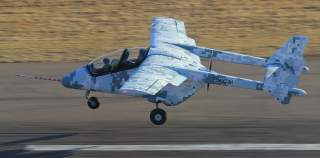Boeing Will Manage the Supply Chain for the Bronco II Counterinsurgency Plane
Here is what we know.
Boeing will manage the supply chain for the Paramount Group’s Advanced High-Performance Reconnaissance Light Aircraft (AHRLAC) counterinsurgency plane—called the Bronco II in the United States—through its subsidiary Aviall.
The U.S. defense giant had previously agreed to market the South African-developed aircraft in the United States as the Bronco II. Meanwhile, the international version of the single-engine turboprop is being marketed as the Mwari. Aviall will support supply chain procurement and management for AHRLAC production for all versions of the aircraft including both military variants. Meanwhile, Boeing’s Global Services unit will provide software-based solutions that enable centralized command and control of flight operations and produce total lifecycle support that reduces sustainment costs, the company said.
“This industry partnership provides not only a specialized aircraft that meets the U.S. customer’s unique mission needs but does so at a fraction of the procurement and lifecycle cost of aircraft with similar mission applications and capabilities,” Eric Strafel, Aviall president and chief executive officer, said.
Recommended: 5 Worst Guns Ever Made.
Recommended: The World’s Most Secretive Nuclear Weapons Program.
Recommended: The Fatal Flaw That Could Take Down an F-22 or F-35.
For the South Africans, the partnership with Boeing is crucial if Paramount hopes to gain a foothold in the U.S. defense market. “The strengthening of our relationship with Boeing Global Services is a key milestone in the introduction of Bronco II into the U.S. market,” Ivor Ichikowitz, Paramount Group chairman, said. “Aviall will help the program scale rapidly in production, as well as help reduce operating costs to the lowest levels ever experienced in an aircraft of this type. Our collaboration with Boeing leverages the strong and diverse design and mission capabilities of both companies to produce and sustain an aircraft for the U.S. and other NATO markets.”
The question, however, is where the Bronco II would fit into the U.S. market? The Bronco II—as Boeing describes it—is a two-crew precision-strike and Command, Control, Communications, Computers, Intelligence, Surveillance and Reconnaissance (C4ISR) aircraft. “It is capable of simultaneously carrying a wide range of weapons, sensors and systems in extended airborne mission operations, and its open system architecture enables rapid incorporation and employment of current and emerging systems,” Boeing states. “The Bronco II Interchangeable Multi-Mission Pod System allows a single airframe to be reconfigured easily to perform multiple roles.”
While not exactly in the same class as the Sierra Nevada/Embraer A-29 Super Tucano and the Textron AT-6 Wolverine, the Bronco II is broadly comparable to those aircraft. But with the U.S. Air Force pushing ahead with another OA-X demonstration with the A-29 and the AT-6 Wolverine for what could become a new tender for a light attack aircraft, the Bronco II seems late to the party. The South African aircraft is essentially shut out of the U.S. Air Force program at the moment unless something changes.
Other than a prospective (but unlikely) U.S. Air Force OA-X buy, it is not clear what other opportunities exist in the U.S. market for the Bronco II. Moreover, it is not clear what opportunities would exist for the aircraft in the international market either. American allies tend to follow the Pentagon’s lead and if Boeing is unable to convince the Pentagon to adopt the Bronco in some quantity, the company’s prospects of selling the aircraft to U.S. partner nations drops precipitously. But only time will tell.
Dave Majumdar is the defense editor for The National Interest. You can follow him on Twitter: @davemajumdar.
Image: AHRLAC Holdings Ahrlac / Wikimedia Commons

